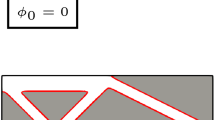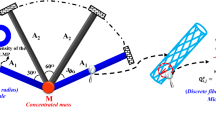Abstract
This paper proposes a novel cascadic multilevel optimization framework for the fiber-reinforced composite structure, inspired by the character of the non-uniform rational basis spline (NURBS) surface, to control the structural topology, fiber angle distribution, and to improve the computational efficiency. The NURBS surface is not only used for the calculation of the structural response and the geometry modeling of the design but also introduced to construct the hierarchy of the parameterization of design variables. The optimization problem is formulated and solved successively from a coarse mesh level to the finest mesh level. The initial design of a fine level is computed using the solution of a coarse level. The number of meshes and design variables is gradually increased, and the design freedom and the resolution of parameterization remain the same to the optimization at the finest mesh level. Because there are fewer design variables and meshes at the coarse level and the finest level is used to find an accurate solution, it efficiently reduces the computational cost of the optimization. Meanwhile, the local support character of the NURBS surface avoids the checkerboard phenomenon and improves the continuity of local fiber angle. Several numerical examples for compliance minimization are presented to verify the effectiveness of the proposed method.




















Similar content being viewed by others
Abbreviations
- NURBS:
-
Non-uniform rational basis spline
- TO:
-
Topology optimization
- SIMP:
-
Solid isotropic material with penalization
- LSM:
-
Level set method
- ESO:
-
Evolutionary structural optimization
- MMC:
-
Moving morphable components
- MMV:
-
Moving morphable void
- MS2L:
-
Multi-scale two-level
- DMO:
-
Discrete material optimization
- FEM:
-
Finite-element method
- IGA:
-
Isogeometric analysis
- MMA:
-
Method of moving asymptotes
References
Zhou M, Rozvany GIN (1991) The coc algorithm, part II: topological, geometrical and generalized shape optimization. Comput Methods Appl Mech Eng 89(1–3):309–336
Bendsoe MP, Sigmund O (1999) Material interpolation schemes in topology optimization. Arch Appl Mech 69:635–654
Sethian JA, Wiegmann A (2000) Structural boundary design via level set and immersed interface methods. J Comput Phys 163:489–528
Wang MY, Wang X, Guo D (2003) A level set method for structural topology optimization. Comput Methods Appl Mech Eng 192:227–246
Allaire G, Jouve F, Toader AM (2004) Structural optimization using sensitivity analysis and a level-set method. J Comput Phys 194:363–393
Huang X, Xie M (2010) Evolutionary topology optimization of continuum structures: methods and applications. Wiley
Guo X, Zhang WS, Zhong WL (2014) Doing topology optimization explicitly and geometrically-a new moving morphable components-based framework. J Appl Mech Trans ASME 81:081009
Zhang WS, Li D, Zhou JH, Du ZL, Li BJ, Guo X (2018) A moving morphable void (mmv)-based explicit approach for topology optimization considering stress constraints. Comput Methods Appl Mech Eng 334:381–413
van de Werken N, Hurley J, Khanbolouki P, Sarvestani AN, Tamijani AY, Tehrani M (2019) Design considerations and modeling of fiber reinforced 3D printed parts. Compos B Eng 160:684–692
Nikbakt S, Kamarian S, Shakeri M (2018) A review on optimization of composite structures part I: laminated composites. Compos Struct 195:158–185
Montemurro M, Catapano A (2019) A general B-Spline surfaces theoretical framework for optimisation of variable angle-tow laminates. Compos Struct 209:561–578
Montemurro M, Catapano A (2017) On the effective integration of manufacturability constraints within the multi-scale methodology for designing variable angle-tow laminates. Compos Struct 161:145–159
Fiordilino GA, Izzi MI, Montemurro M (2020) A general isogeometric polar approach for the optimisation of variable stiffness composites: application to eigenvalue buckling problems. Mech Mater 153:103574
Izzi MI, Montemurro M, Catapano A, Pailhès J (2020) A multi-scale two-level optimisation strategy integrating a global/local modelling approach for composite structures. Compos Struct 237:111908
Montemurro M, Catapano A (2016) A new paradigm for the optimum design of variable angle tow laminates. Springer
Scardaoni MP, Montemurro M (2020) Convex or non-convex? On the nature of the feasible domain of laminates. Eur J Mech A Solid 85:104112
Izzi MI, Catapano A, Montemurro M (2021) Strength and mass optimisation of variable-stiffness composites in the polar parameters space. Struct Multidiscip Optim 64:2045–2073
Catapano A, Montemurro M (2020) Strength optimisation of variable angle-tow composites through a laminate-level failure criterion. J Optim Theory Appl 187:683–706
Ghiasi H, Pasini D, Lessard L (2009) Optimum stacking sequence design of composite materials part I: constant stiffness design. Compos Struct 90:1–11
Ghiasi H, Fayazbakhsh K, Pasini D, Lessard L (2010) Optimum stacking sequence design of composite materials part II: variable stiffness design. Compos Struct 93:1–13
Xia Q, Shi TL (2017) Optimization of composite structures with continuous spatial variation of fiber angle through shepard interpolation. Compos Struct 182:273–282
Tian Y, Pu S, Zong Z, Xia Q (2019) Optimization of variable stiffness laminates with gap-overlap and curvature constraints. Compos Struct 230:111494
Stegmann J, Lund E (2005) Discrete material optimization of general composite shell structures. Int J Numer Methods Eng 62:2009–2027
Tian Y, Pu S, Shi T, Xia Q (2021) A parametric divergence-free vector field method for the optimization of composite structures with curvilinear fibers. Comput Methods Appl Mech Eng 373:113574
Brampton CJ, Wu KC, Kim HA (2015) New optimization method for steered fiber composites using the level set method. Struct Multidiscip Optim 52:493–505
Papapetrou VS, Patel C, Tamijani AY (2020) Stiffness-based optimization framework for the topology and fiber paths of continuous fiber composites. Compos B 183:107681
Xia ZH, Wang YJ, Wang QF, Mei C (2017) Gpu parallel strategy for parameterized lsm-based topology optimization using isogeometric analysis. Struct Multidiscip Optim 56:413–434
Li WC, Suryanarayana P, Paulino GH (2020) Accelerated fixed-point formulation of topology optimization: application to compliance minimization problems. Mech Res Commun 103:103469
Liao ZY, Zhang Y, Wang YJ, Li W (2019) A triple acceleration method for topology optimization. Struct Multidiscip Optim 60(2):727–744
Ding H, Xu B (2021) A novel discrete-continuous material orientation optimization model for stiffness-based concurrent design of fiber composite. Compos Struct 273:114288
Xia Q, Shi T (2018) A cascadic multilevel optimization algorithm for the design of composite structures with curvilinear fiber based on Shepard interpolation. Compos Struct 188:209–219
Shi S, Zhou P, Lü Z (2021) A density-based topology optimization method using radial basis function and its design variable reduction. Struct Multidiscip Optim 64:2149–2163
Hughes TJR, Cottrell JA, Bazilevs Y (2005) Isogeometric analysis: CAD, finite elements, NURBS, exact geometry and mesh refinement. Comput Methods Appl Mech Eng 194:4135–4195
Nguyen VP, Anitescu C, Bordas SPA, Rabczuk T (2015) Isogeometric analysis: an overview and computer implementation aspects. Math Comput Simul 117:89–116
Gao J, Xiao M, Zhang Y,Gao L.(2020)A comprehensive review of isogeometric topology optimization: methods, applications and prospects.Chin J Mech Eng 33:87
Seo YD, Kim HJ, Youn SK (2010) Isogeometric topology optimization using trimmed spline surfaces. Comput Methods Appl Mech Eng 199:3270–3296
Gao J, Gao L, Luo Z, Li P (2019) Isogeometric topology optimization for continuum structures using density distribution function. Int J Numer Methods Eng 119:991–1017
Gao J, Xue H, Gao L, Luo Z (2019) Topology optimization for auxetic metamaterials based on isogeometric analysis. Comput Methods Appl Mech Eng 352:211–236
Gao J, Luo Z, Xiao M, Gao L, Li P (2020) A NURBS-based multi-material interpolation (N-MMI) for isogeometric topology optimization of structures. Appl Math Model 81:818–843
Roiné T, Montemurro M, Pailhès J (2021) Stress-based topology optimization through non-uniform rational basis spline hyper-surfaces. Mech Adv Mater Struct 1:1–29
Costa G, Montemurro M, Pailhes J (2019) Minimum length scale control in a NURBS-based SIMP method. Comput Methods Appl Mech Eng 354:963–989
Tavakkoli S, Mehdi S (2017) An isogeometrical approach to structural level set topology optimization. Comput Methods Appl Mech Eng 319:240–257
Hao P, Yuan X, Liu C, Wang B, Liu H, Li G (2018) An integrated framework of exact modeling, isogeometric analysis and optimization for variable-stiffness composite panels. Comput Methods Appl Mech Eng 339:205–238
Costa G, Montemurro M, Pailhès J (2021) NURBS hypersurfaces for 3D topology optimisation problems. Mechanics of advanced materials and structures. Mech Adv Mater Struct 28(7):665–684
Montemurro M, Bertolino G, Roiné T (2021) A general multi-scale topology optimisation method for lightweight lattice structures obtained through additive manufacturing technology. Compos Struct 258:113360
Bertolino G, Montemurro M (2021) Two-scale topology optimisation of cellular materials under mixed boundary conditions. Int J Mech Sci 216:106961
Montemurro M, Refai K, Catapano A (2022) Thermal design of graded architected cellular materials through a CAD-compatible topology optimisation method. Compos Struct 280:114862
Liu H, Yang D, Hao P, Zhu X (2018) Isogeometric analysis based topology optimization design with global stress constraint. Comput Methods Appl Mech Eng 342:625–652
Spink M, Claxton D, Falco C de, Vazquez R (2010) NURBS toolbox. Octave Forge. Accessed 29 June 2007, https://octave.sourceforge.io/nurbs/overview.html
Svanberg K (2002) A class of globally convergent optimization methods based on conservative convex separable approximations. SIAM J Optim 12:555–573
Wang Y, Benson DJ (2016) Isogeometric analysis for parameterized LSM-based structural topology optimization. Comput Mech 57:19–35
Funding
This work was supported by the National Natural Science Foundation of China (11872311) and the Natural Science Basic Research Plan in Shaanxi Province of China (2020JM085).
Author information
Authors and Affiliations
Corresponding authors
Ethics declarations
Conflict of interests
The authors declared no potential conflicts of interest with respect to the research, authorship, and publication of this article.
Additional information
Publisher's Note
Springer Nature remains neutral with regard to jurisdictional claims in published maps and institutional affiliations.
Rights and permissions
About this article
Cite this article
Ding, H., Xu, B., Duan, Z. et al. A cascadic multilevel optimization framework for the concurrent design of the fiber-reinforced composite structure through the NURBS surface. Engineering with Computers 39, 2735–2756 (2023). https://doi.org/10.1007/s00366-022-01639-0
Received:
Accepted:
Published:
Issue Date:
DOI: https://doi.org/10.1007/s00366-022-01639-0




